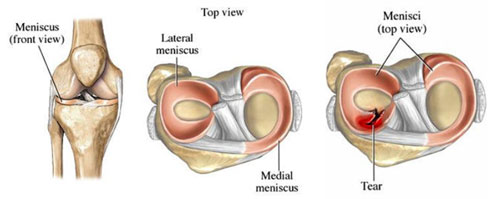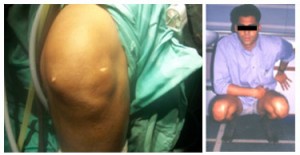What is a meniscus?
A meniscus is a C-shaped cushion made of fibrocartilage interposed between the thigh bone (femur) and the leg bone (tibia). There are two menisci in each knee – one on the inner side of the knee (medial side) and one on the outer side (lateral side) of the knee.

The function of the menisci is:
1. To act as shock absorbers of the knee.
2. To evenly distribute the weight of the body across the knee.
3. To increase the congruity of the bones of the knee to each other.
How does one get a meniscal tear?
A meniscal tear can occur due to a twisting injury to the knee while playing sport or during activities of daily living (ADL). These are called traumatic meniscal tears. Meniscal tears may also occur in the absence of an injury in an arthritic knee due to a worn out meniscus. These are called degenerative meniscal tears.
How are meniscal tears diagnosed?
Meniscal tears are diagnosed on the basis of the history of injury to the knee, patient’s symptoms and physical examination. The most common symptoms of meniscal tear are:
1. Pain
2. Swelling (collection of fluid)
3. Locking or catching of the knee
4. Knee buckling (giving way)
5. Difficulty in bending or straightening the knee
There are certain specific clinical tests like the McMurray’s test and Apley’s grinding test which point towards a meniscal tear.
Are there any tests for diagnosing meniscal tears?
X-rays and MRI scan are two tests which are commonly employed in patients with meniscal tears. X-rays are usually normal in a young patient with meniscal tears. In older patients with degenerative type of a meniscal tear X-rays will reveal changes of arthritis. MRI scanning is a sensitive test for detecting meniscal tears. It will also reveal any associated soft tissue injuries like an ACL tear.
Do meniscal tears heal on their own?
Healing of a meniscus, like any other tissue in the body, depends on blood circulation. Only the outer one-third of the meniscus has direct blood supply which comes from the peripheral capsule. This means that only peripheral tears in the outer third of the meniscus have the potential to heal by themselves. Healing of a meniscal tears is dictated by:
1. Location of the tear.
2. Size of the tear.
3. Whether the tear is stable or unstable.
Treatment of meniscal tears
1. NON-SURGICAL TREATMENT
Every patient with a meniscal tear does not need surgery. Most meniscal tears can be treated initially with rest, ice application, compression bandage and elevation (RICE). This is followed by physiotherapy to strengthen the knee.
2. SURGICAL TREATMENT
Patients whose symptoms do not resolve with the above treatment and those patients who present with a locked knee will need surgery. This involves arthroscopic surgery (key-hole surgery). There are two possible options:
1. Meniscal repair: This involves repairing the torn portion to the intact portion of the meniscus. The advantage of this method is that it preserves the entire meniscus. However not all meniscal tears are repairable, and the recovery after meniscal repair takes much longer.
2. Menisectomy: This involves removing only the torn portion of the meniscus but leaving behind the intact part of meniscus. Patients are able to rehabilitate faster after menisectomy.
What are the consequences of undergoing a menisectomy?
Knee function following a menisectomy (removal of torn meniscus) is very good. The part of the meniscus removed does not grow back, but is replaced by fibrous tissue. There is an increased likelihood of developing osteoarthritis in patients who have undergone complete (total) menisectomy. It is therefore important to leave behind as much of normal meniscus as is possible. Fortunately total menisectomy is very rarely required.
What is the post-operative course after arthroscopic meniscal surgery?
Both menisectomy as well as meniscal repair may be performed as day care surgery. The post-operative course depends on whether a menisectomy or a meniscal repair has been performed. After menisectomy the patient is encouraged to walk the same day, if necessary with a walking aid. Muscle strengthening and knee bending exercises are initiated immediately. Most patients are able to return to work in 1-2 weeks’ time.
After meniscal repair the patient is advised to walk with a straight knee brace and a walking aid for 3-4 weeks. The knee brace is used in order to limit knee bending to allow the repaired meniscus to heal. Static muscle strengthening exercises are started immediately. Once the brace is removed at 3-4 weeks, the patient is started on full rehabilitation which includes knee bending exercises. Full recovery may take about 6-8 weeks.
Are there any risks and complications associated with meniscus surgery?
Generally speaking, surgeries for meniscal tears are safe and the complications rates are very low. Meniscetomy (removal of torn fragment) is virtually complication free. After meniscal repair there is potential risk of non-healing of the repaired tear. This possibility can be minimized by proper case selection.
Case illustration
This illustration is of a young man aged 22 years who had a twisting injury to his left knee while playing football. He complained of pain in his left knee especially on knee bending for about two months. His clinical examination was suggestive of a meniscal tear, and a MRI scan confirmed that he had tear in his meniscus. This was treated with arthroscopic (key-hole) surgery. He underwent removal of the torn fragment of his meniscus. He regained full function after surgery.

1. Arthrocopic surgery performed using two small key-holes
2. Post-operative status 4 weeks after surgery-full function regained
- To act as shock absorber of the knee.
